THE MINI-SOCCER AND YOUTH FUTSAL HANDBOOK





There is nothing more important in football than keeping players, coaches, spectators and everyone involved safe. If we can do that we can all enjoy the game we love.
Deliberate Heading Allowed No – if occurs an indirect free kick to the opposition No – if occurs an indirect free kick to the opposition No – if occurs an indirect free kick to the opposition
Yes unless league has opted to include U10s
Allowed No – if occurs an indirect free kick to the opposition No – if occurs an indirect free kick to the opposition No – if occurs an indirect free kick to the opposition No – if occurs an indirect free kick to the opposition
U7-U9 (2024/25) AND U7-U10 (2025/26)
Traditional throw-Ins will no longer take place and will be replaced by a pass or dribble-in.
For more details click here.
No deliberate heading for Under 7s up to and including Under 9s.
Deliberately heading the ball is an offence punishable by an indirect free kick. The indirect free kick is taken at the point where the ball was deliberately headed, except:
Where a player deliberately heads the ball within their own penalty area, the referee will stop the game and restart with an indirect free kick to the opposition from the nearest side line of the penalty area where the offence took place.
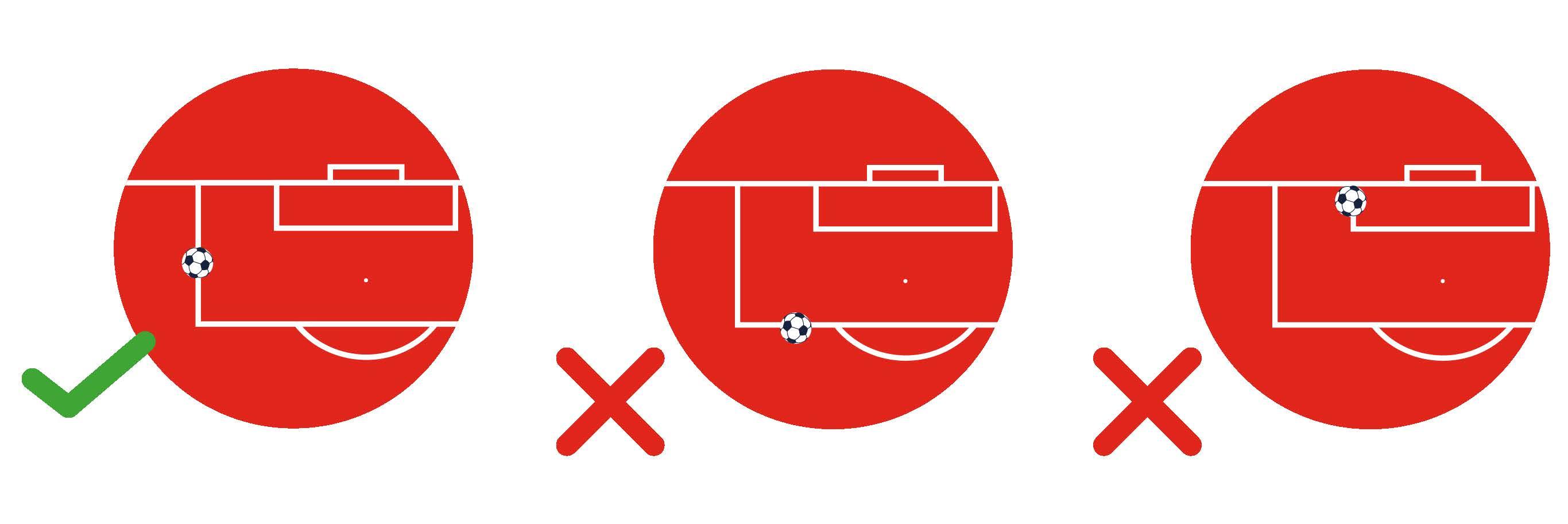
Heading guidance in training for all age groups between under 6 and under 18.
No heading in training in the foundation phase (primary school children).
Graduated approach to heading training for children in the development phase between under 12 to under 16.
Required ball sizes for training and matches for each age group – under 7s to under 10s will play with a size 3 ball.
No deliberate heading in matches for Under 7s up to and including Under 9s.*
All other age groups can head the ball in matches.
*For the 2025/26 season this will change to no deliberate heading in matches for Under 7s up to and including Under 10s in matches.
For age groups u5 to u11 heading should NOT be introduced in training sessions.
Coaches should use the time they have with players to maximise enjoyment and development of other skills, particularly the fundamentals of working with the ball in their hands and feet.
Focus should be on learning to master the ball and control of the body through fun activities.
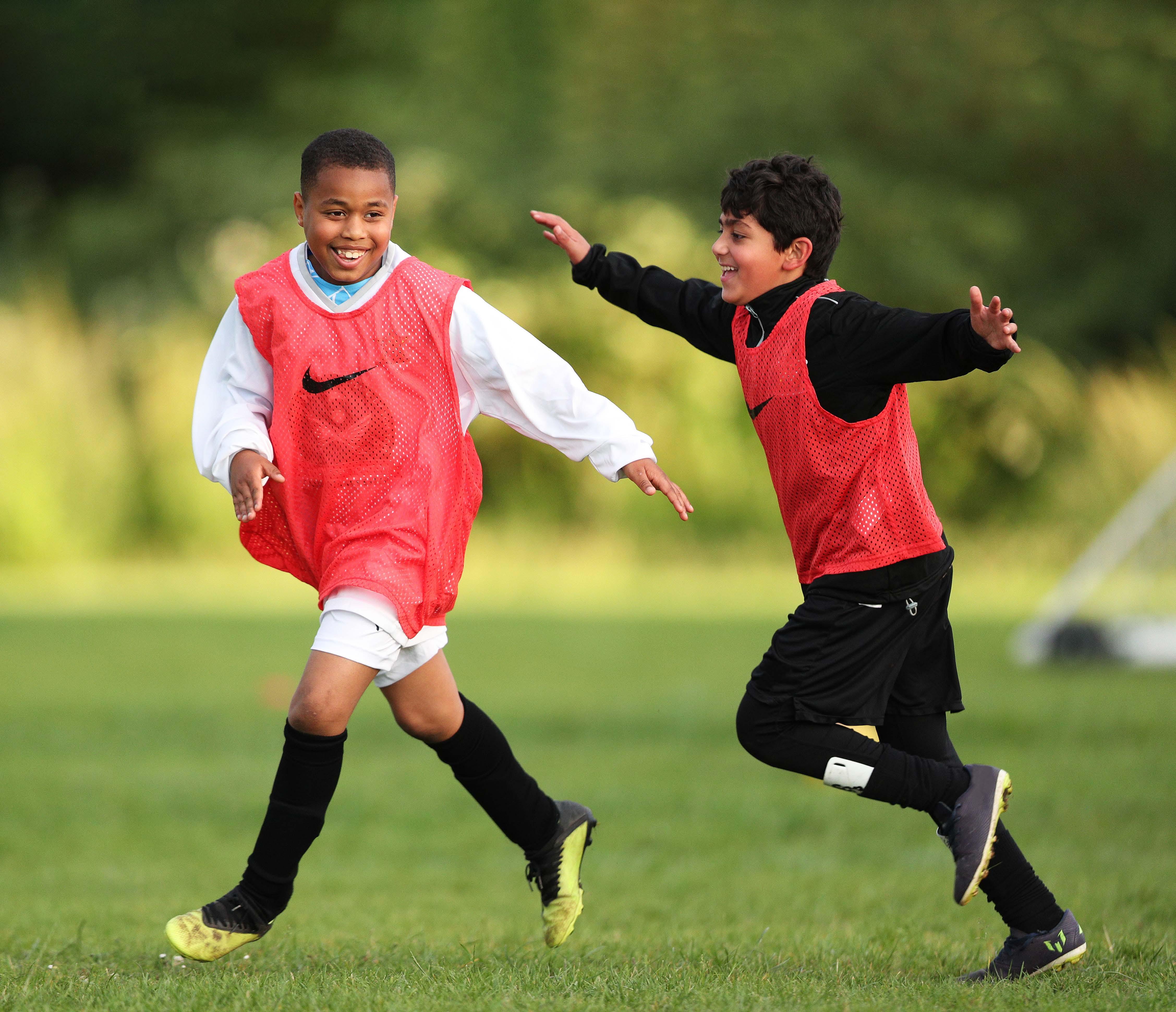
www.englandfootball.com/participate/ learn/Brain-Health/Heading-in-Football
Without Laws there would be no football. But when very young children play there are many other things to consider too.
Can we make sure that everyone, children AND adults, has an enjoyable time?
If the pitch is fit to play, is the weather appropriate for small children?
Is there any reason why EVERY child should not be able to enjoy at least 50% game time on the day?
If we can all apply these principles just as much as the Laws themselves, then we should see more and more children enjoying the greatest game in the world.
Players will play to the laws of the game of the age-group that they are playing in.
We want to provide a safe, fun and positive environment in which young people can play and enjoy football.
This can be achieved if everyone plays their part in supporting and promoting Respect.
Here are some of the things you can do to help:
Welcome the opposition and treat them how you would like to be treated.
Support and encourage players from both sides. Let the coaches coach.
Remember that the referee may be learning the game.
You are a role model to children at all times during the game.
Always make the game fun.
Do not go onto the pitch unless a child is injured.
Show children how to win or lose in the right way.
To find out more about Respect go to: www.englandfootball.com/participate/explore /inclusive-football/Respect
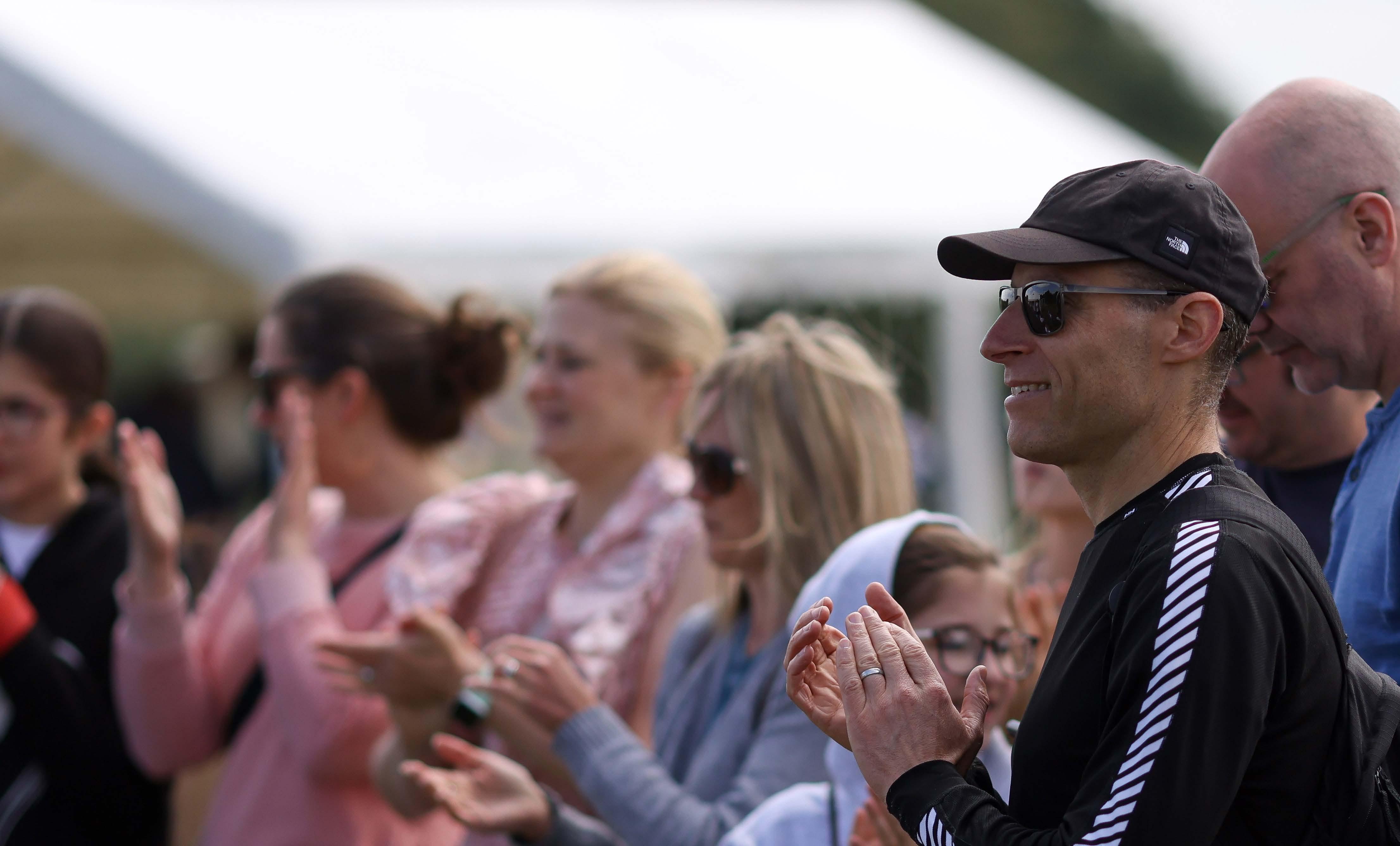

Silent Support helps create a more positive space for players, coaches and spectators. The idea is to cut down on unnecessary distraction from the side lines.
Instead of confusing shouts and rebukes from spectators, players are encouraged by their applause only. Rather than hearing lots of voices offering conflicting instructions, players might only hear the voice of their coach – or from no-one at all if that’s the way you want to play it.
This season Leagues can choose to run Silent Support games, they may do this for different reasons.
If side line behaviour at games is poor. Use Silent Support to quieten down your spectators – or even coaches – to create a calmer playing environment. If younger players are getting confused by too much advice. With Silent Support, the only voice players hear is their coaches’, cutting out conflicting instructions.
To find out more about Silent Support go to: community.thefa.com/leagues-clubs/b/blog/ posts/silent-support
There will also be a national initiative, but all leagues will be notified and can choose to take part.
Signing for an academy is an exciting opportunity, but it’s also an introduction to the highly competitive, complex nature of football. The PFA is not affiliated with leagues, clubs or governing bodies, so they can provide accurate, free, impartial information and advice about the academy system and what it entails for young players and their families. They operate a free, confidential service where you can get advice about:
• Premier League and English Football League youth-development rules
• Academy registrations, inductions and contractual offers
• Football Association and FIFA regulations scholarship offers
Children from U7– U10 do not play in leagues. They can play in a maximum of three trophy events during the season.
This allows them to learn about winning and losing in a fun environment. Trophies can be awarded to the winners and the results of the mini-event published.
U7s - U8s
When you see this symbol, rotate your device to see the diagram in more detail.
All sizes, times or numbers shown are the maximum allowed unless otherwise stated (FA Standard Code of Regulations –Youth [SCORY]. All diagrams are shown with 7 versus 7 for illustrative purposes only.

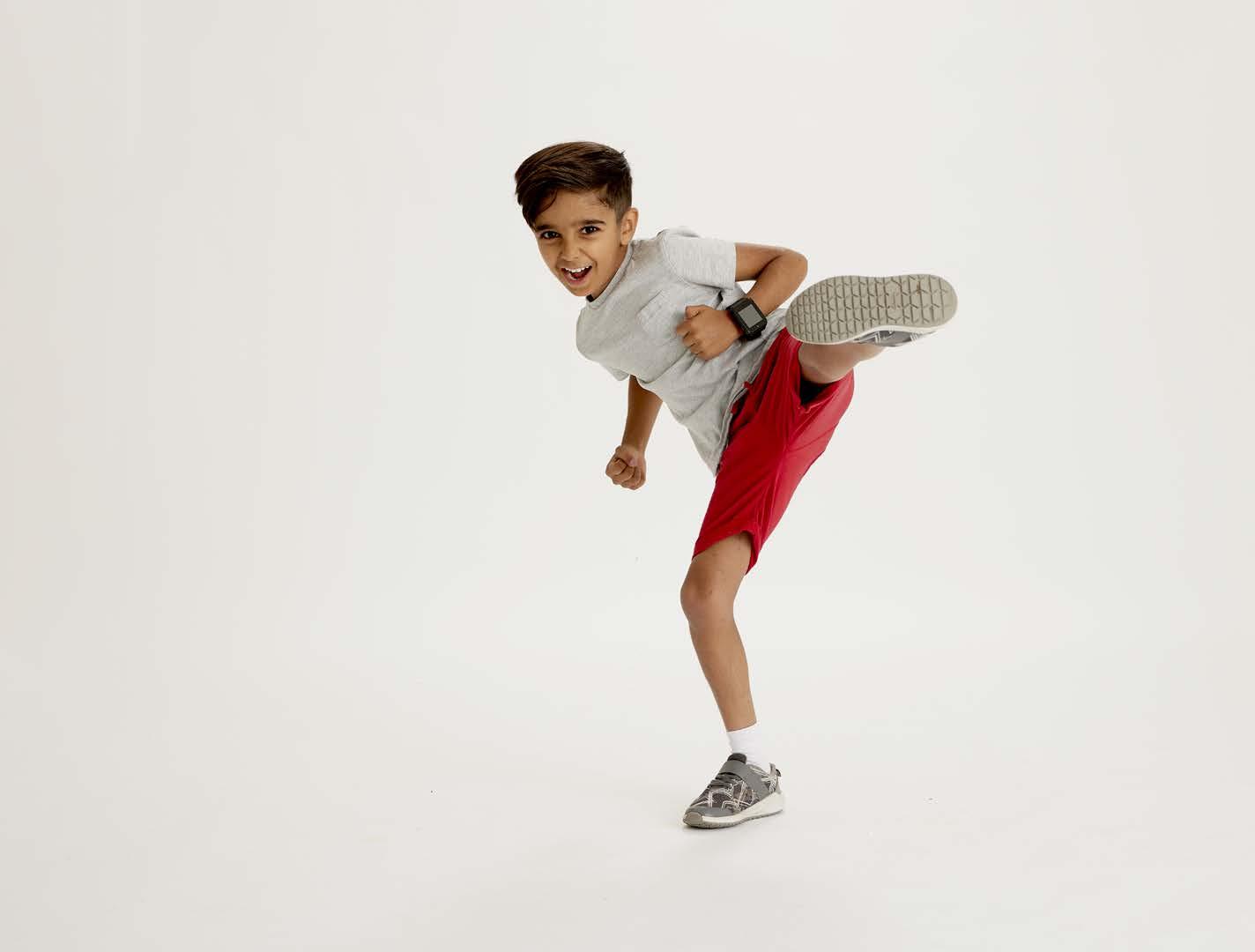
Childhood is a magical time of infinite possibilities, hope and potential! To help our young children we have developed Play Phase for children age 4-6 as England Football’s Early Years philosophy. The fun of taking part in games while keeping active can make a huge and positive difference that lasts a lifetime. So, let’s lay these good foundations early.
Play Phase is about encouraging children in skills and learning that will eventually be useful not just in football, but in life. It makes learning fun, playful and creative, for lifelong benefits.
To find out more about Play Phase go to: www.englandfootball.com/play/ ways-to-play/play-phase
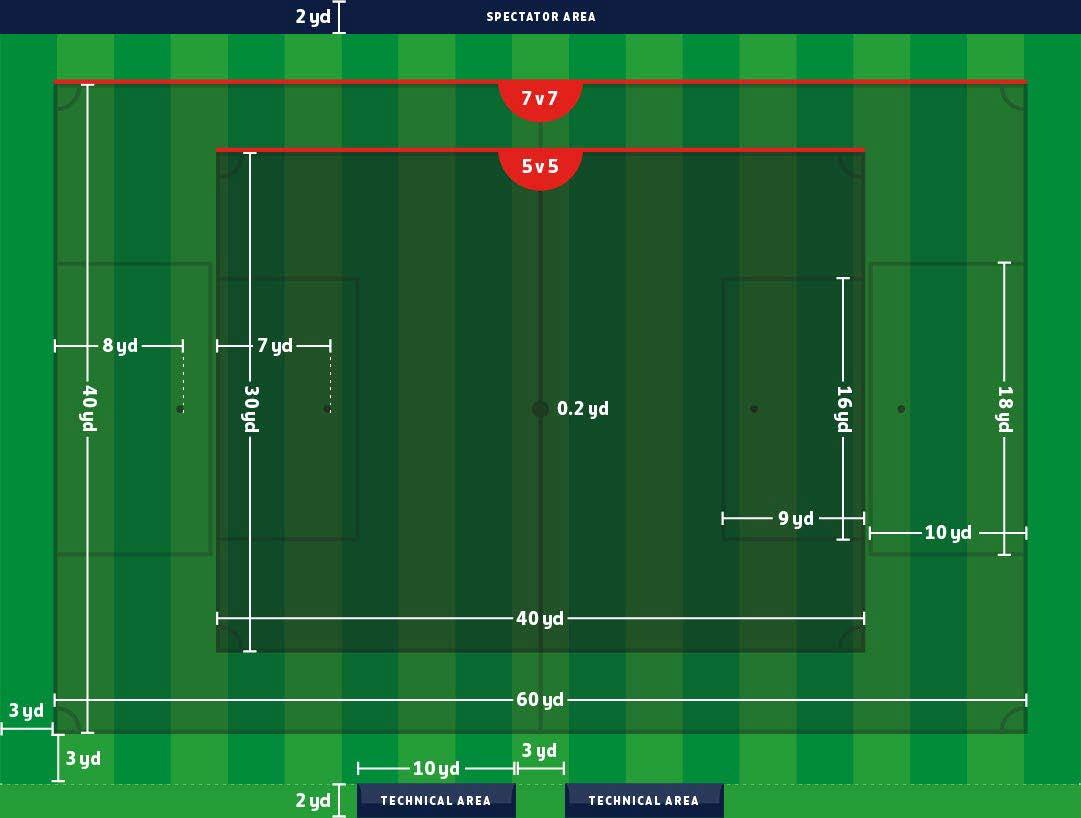
Playing areas are for development football matches for those aged from u7/8 & u9/10.
• Kick offs: these are taken from the centre mark on the half way line.
• Retreat line: the team without the ball moves back to the half way line when goal kicks are taken.
• Goal sizes: the goal size for Mini-Soccer is 12ft × 6ft.

U7s - U10s Size 3
• U7s - U10s should use a size 3 ball.
• The ball should be safe for children to play with and made of leather or another suitable material.

Maximum number of players by age:
U7s - U8s
U9s - U10s 5 v 5 7 v 7
• U7s – 8s: the maximum number of players per team is 5v5 with a squad of 10 or less.
• U9s – 10s: the maximum number of players per team is 7v7 with a squad of 14 or less.
• Coaches can be flexible outside of Trophy Events
• The FA is strongly of the opinion that there are technical benefits to be gained by playing formats of the game using smaller numbers such as 4v4, 3v3, 2v2.
• The structure of Development football lends itself to playing in a variety of different competitive formats across the season. Leagues should be flexible with fixtures.
• Reds U7s and Blues U7s, each with 7 registered players, could play a 4v4 and a 3v3 instead of a 5v5 and two substitutes, where facilities allow. The FA recommends that coaches should seek to provide these different challenges.
• Roll-off roll-on substitutions can be made at any time during the game with permission from the referee, including players who have already been substituted.
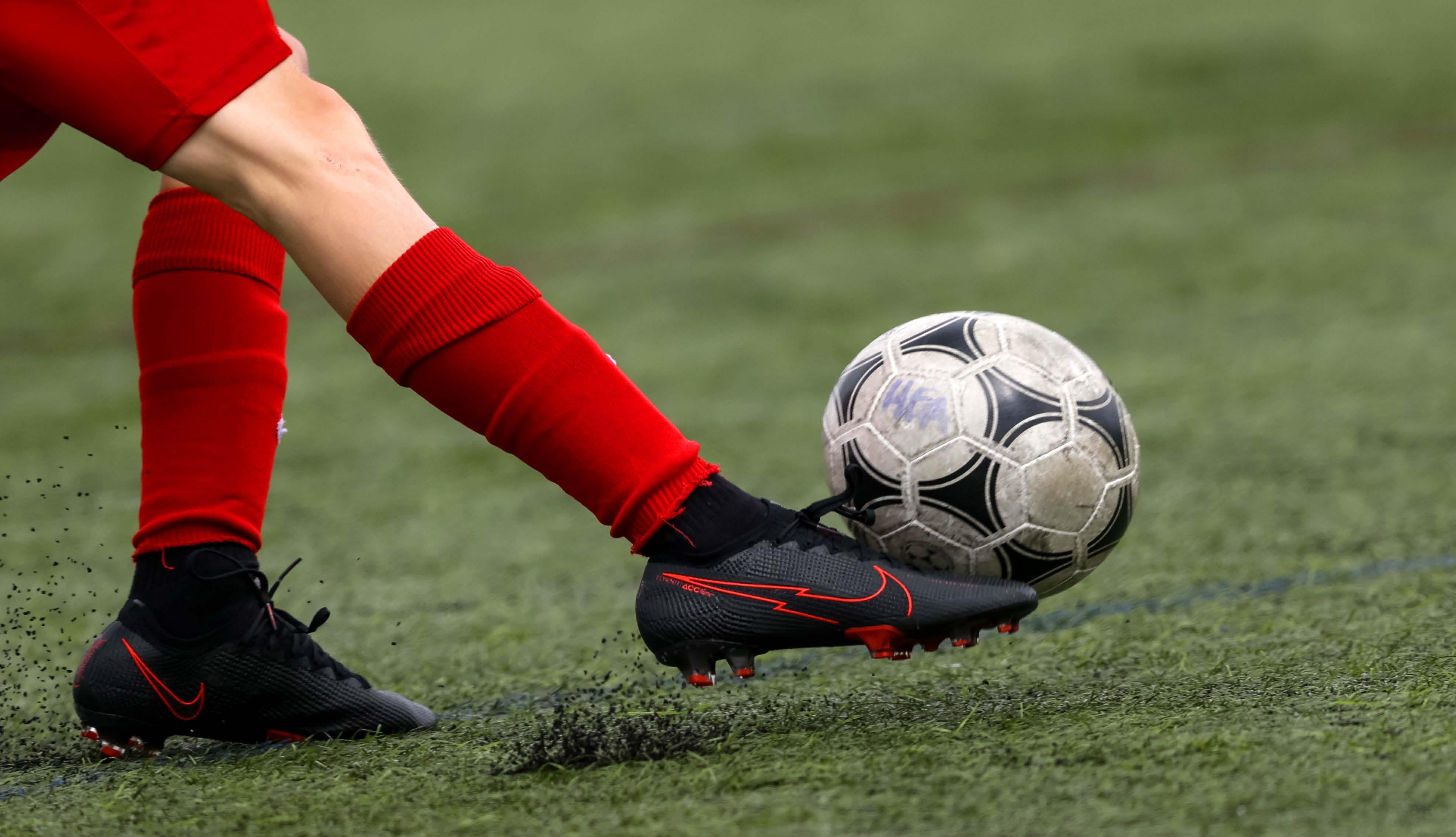
• Children can not play Development Football without shin pads.
• These should be covered entirely by knee length socks. Click here for guidance on use of shin pads in grassroots football.
• Goalkeepers should wear a different coloured shirt to the rest of the team.
• Footwear should be appropriate for the playing surface – no metal studs on 3 and AGP pitches.
• If the weather is poor then players should wear appropriate clothing, but hoodies are not allowed.
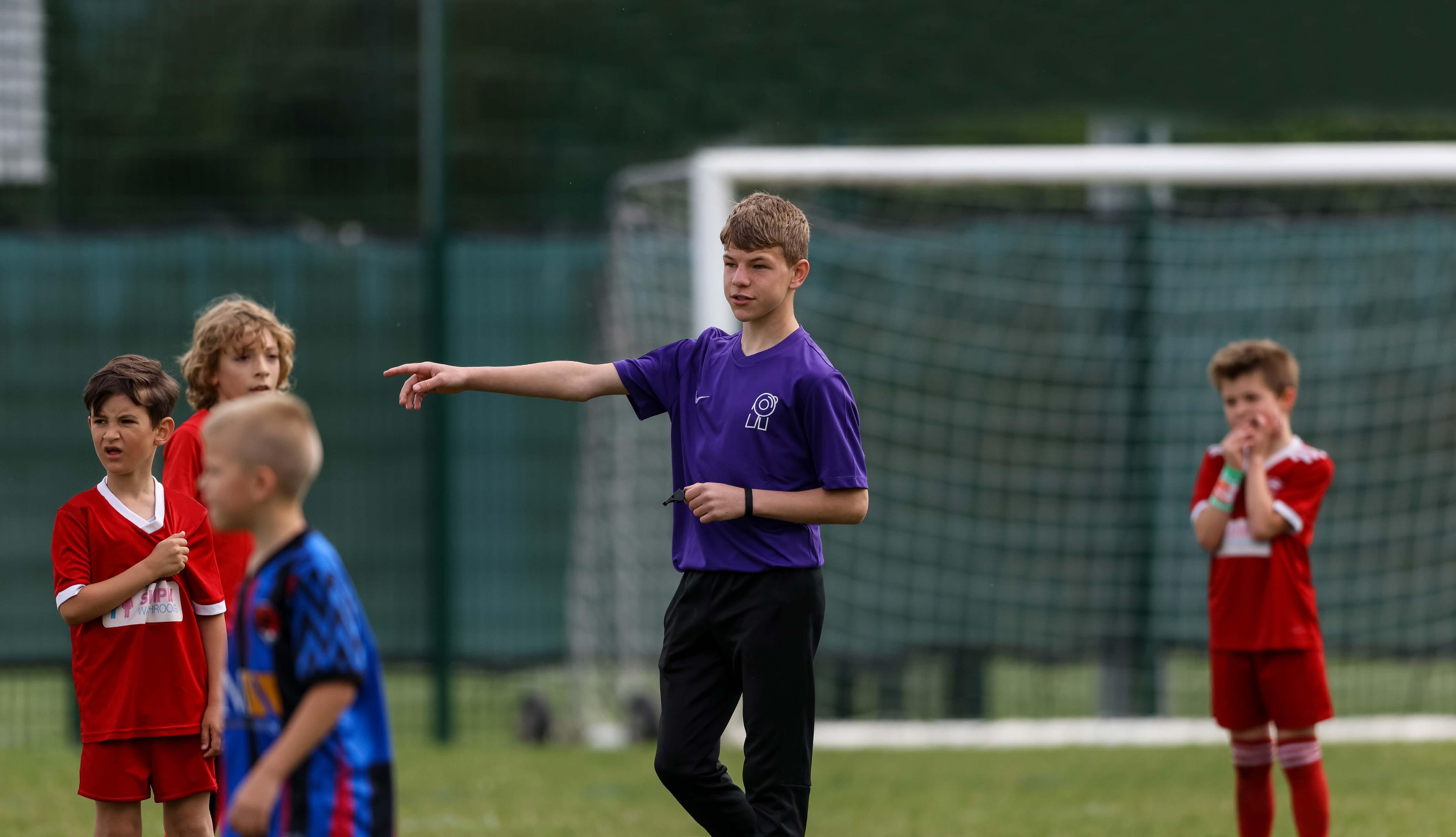
• Any person who referees a game of Development Football has the authority to apply the Laws of Mini-Soccer even if they are not a fully qualified referee.
• The referee should always help the players to learn the game by explaining their decisions.
• Assistant referees are not required for Development Football.
• Children should not exceed the maximum playing time for their age in any one day. It is the responsibility of the junior club and/or the child’s parent or carer to ensure this.
• Each league is allowed to determine its own playing time up to the maximum allowed.
• Half time should not be more than five minutes.
• Development games can be split into quarters within the maximum playing time allowed.
• For tournament football see the Standard Code of Rules for Youth Competitions. Age
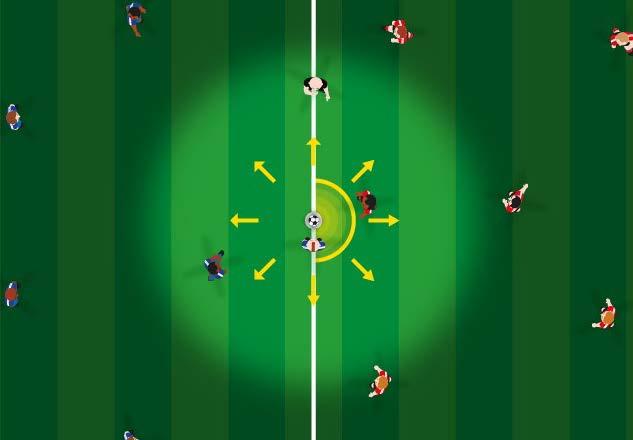
• A kick off from the centre mark starts the game, or restarts it after a goal is scored.
• It can be taken in any direction.
• The opposition must be five yards away and in their own half.

• In Mini-Soccer a goal cannot be scored directly from a kick off or a dropped ball.
• In special circumstances a drop ball is used to restart the game, such as after an injury.
• If the game has stopped with the ball in the penalty area, the drop ball should be taken on the penalty area line (pictured).

• The goal line and touchlines are part of the field of play. The ball must be entirely over these lines to be out of play (pictured).
• If an attacker is the last player to touch the ball over the goal line, a goal kick is given.
• If a defender is the last player to touch the ball over the goal line, a corner kick is given.
• If a player touches the ball over the touchline, a “Pass or Dribble-In” is given to the opposing team.

• A goal is scored when the ball completely crosses the goal line between the posts and under the crossbar of the goal (pictured).
• If a foul or hand ball occurs the goal shall be disallowed.

• There is no offside in Development Football.
• The children can be in any area of the pitch at any time (pictured) apart from when the Retreat Line is played.
• Free kicks are awarded when a foul is committed as in older age football.
• In mini soccer all free kicks are direct, except when a deliberate header has occurred.
• A goalkeeper is not allowed to pick the ball up from a back pass or a throw in.
• If this happens a free kick should be given on the penalty area line closest to where the incident occurs.
• For Under 7s to Under 9s (2024/25 season) and for Under 7s to Under 10s (2025/26 season); Deliberately heading the ball is an offence punishable by an indirect free kick. The indirect free kick is taken at the point where the ball was deliberately headed, except: Where a player deliberately heads the ball within their own penalty area, the referee will stop the game and restart with an indirect free kick to the opposition from the nearest side line of the penalty area where the offence took place. (See page 4 for the diagram)
• As with all other aspects of Development Football the children should be learning the game. Coaches in training, and referees on the day, should try to make sure the children understand all of the above.
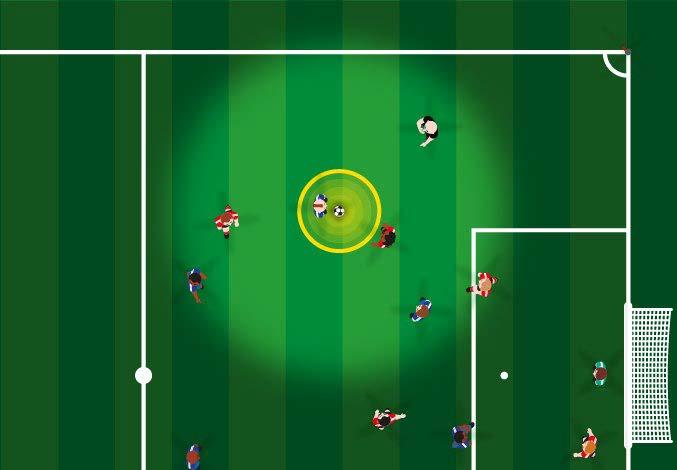
• For all free kicks defending players must be 5 yards from the ball (pictured).

• If a foul is committed in the penalty area by a defender a penalty kick will be awarded.
• All players except the defending goalkeeper and kicker must be outside the penalty area and at least 5 yards from the penalty mark.
• The ball must be kicked forward.
U7-U9 (2024/25) AND U7-U10 (2025/26)
• When the whole of the ball passes over the touchline, on the ground or in the air, instead of a throw-in, a pass-in or dribble-in is awarded.
• A kicker taking a pass-in may choose to touch the ball again before it is touched by another player
At the moment of delivering the ball:
• The ball must be stationary on the touchline at the point where it left the pitch; only the kicker may be off the pitch.
• All opponents must stand at least 5 yards from the point on the touchline where the pass-in or dribble-in is to be taken.
A goal cannot be scored directly from a pass-in.
The ball is in play when it is kicked and clearly moves. For more information, including a video please click here.
U10s only in 2024/25: Normal throw-ins are allowed.

• If an attacking player kicks the ball over the goal line a goal kick is awarded to the defending team.
• A goal kick can be taken from any point within the penalty area and by any player from the team with the ball (pictured).

• The team without the ball must retreat to their own half until the ball is in play.
• This is known as the Retreat Line (PICTURED).
• Once the ball is in play, the team without the ball can try and win it back.
• As with all the Laws of Development Football, the referee should help the players learn the game.

• If a defending player kicks the ball over the goal line a corner is awarded to the attacking team.
• The defending players must remain at least 5 yards from the ball until it is in play (PICTURED).
• The player taking the corner may not touch the ball again until it has touched another player.
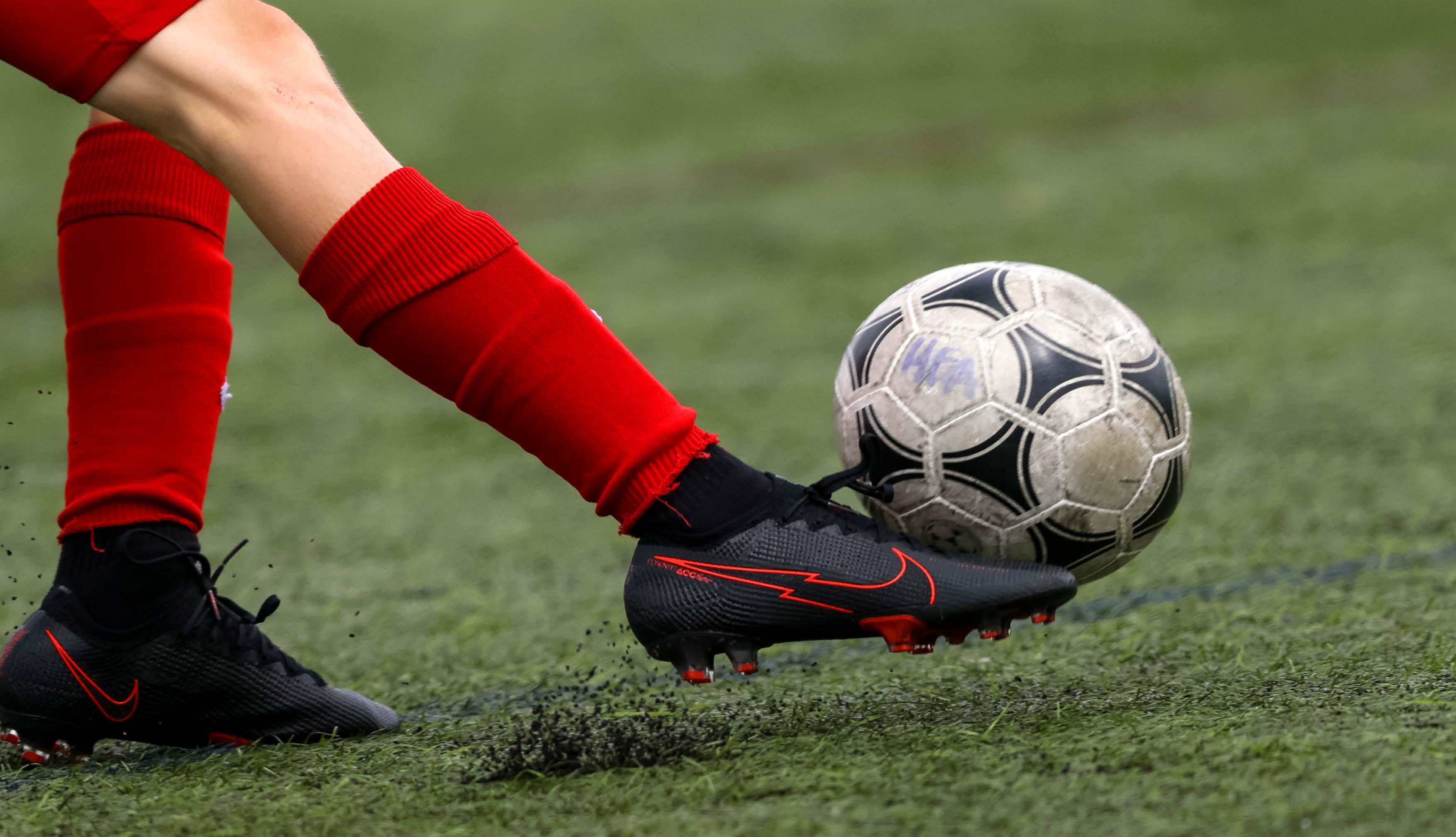
Development football is designed to create the best learning and fun experience for young players. To ensure an imbalance in ability does not spoil this, the FA has approved ‘Power Play’ as an option that mini-soccer and youth leagues can adopt.
• If a team is losing by a four goal difference they can put an additional player on –so 5v5 becomes 6v5.
• If the score returns to less than a four goal difference the team takes off a player. It does not have to be the last player to come on.

• If a team goes on to be losing by a six goal difference a further additional player can be added – so 6v5 becomes 7v5.
• The main aim of the Power Play option is that all players are being challenged and enjoying the game.
• Power Play is available through all mini soccer football formats 5v5 and 7v7.
* This does not need to be the same player that was put on as the additional player.
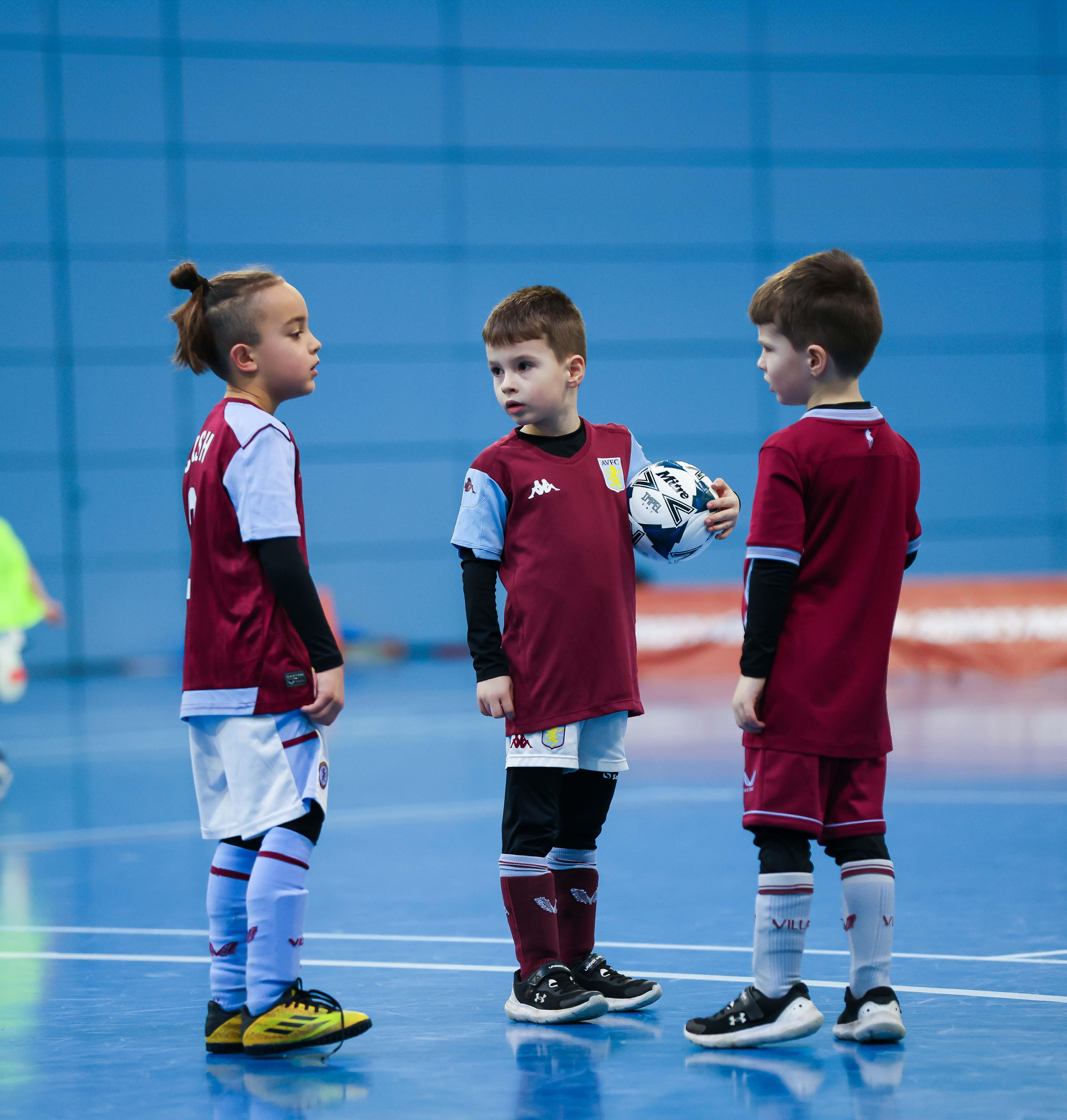
This is an introduction to the Laws of Futsal so that more and more people can begin to play and enjoy the game. They are the basics that make it quite different from traditional 5v5 football.
Coaches of young players should ensure they have an understanding of the basic laws detailed in this guide before a match, but this is a great way to start children playing and enjoying the game.
Read the FIFA Laws of Futsal
When you see this symbol, rotate your device to see the diagram in more detail.
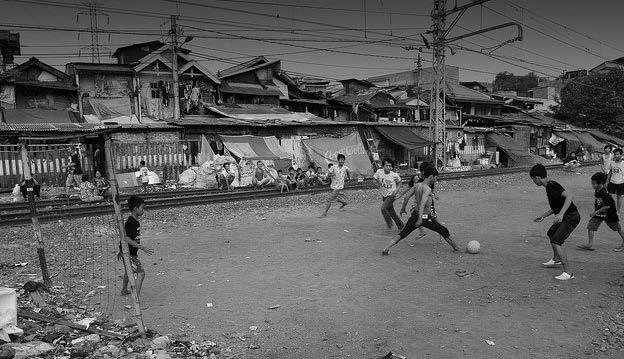
Futsal was first played on basketball courts in Uruguay in the 1930s. As a fast moving, skilful version of football it soon spread to other South American countries such as Brazil.
Futsal became popular in large crowded cities where there was a shortage of pitches for football.
The skills and techniques developed by playing Futsal were very apparent in the wonderful World Cup winning Brazilian teams.

Now Futsal is recognised not only as a development tool for football, but as a brilliant game in its own right. Futsal has been embedded into the England DNA. It is a great way to keep children playing during the winter months. Players of all ages love to play Futsal.
1
“ As a little boy in Argentina, I played Futsal on the streets and for my club. It was tremendous fun, and it really helped me become who I am today.”
— Lionel Messi
2
3
“ During my childhood in Portugal, all we played was Futsal, the small playing area helped me improve my close control and whenever I played Futsal, I felt free. If it wasn’t for Futsal, I wouldn’t be the player I am today.”
— Christiano Ronaldo
“ The technique of playing Futsal is different to the eleven-a-side version; there are spectacular things you can attempt that you would not dare trying in football. It adds more fun to the discipline.”
— Zinadine Zidane

• Futsal playing area dimensions are above.
• A hard surface is required. Indoors is preferable but outdoors on a hard surface is ok. The game can not be played on grass or on AGP pitches.
• The pitch has marked lines so that the ball can go out of play. Futsal can not be played with board or wall surrounds.

U12 and under
Size 3 Futsal ball
U 13 - seniors
Size 4 Futsal ball
• Playing with a Futsal ball is essential.
• The ball is smaller, heavier and bounces less than a normal football.
• Futsal balls are available in age appropriate sizes.

• Futsal goals are 3m × 2m (the same as Hockey or Handball goal size).
• The goalposts and crossbars should be a different colour to the pitch.
• Safety is always the first consideration with any goalposts. The goals should be secured so that they do not collapse or overturn.
• Portable goals should only be used if they comply with the above.

• Two referees are normal at games in order to apply the Laws of Futsal but one can manage with younger age groups (U10 and below). At international level there are two referees, a third official and a timekeeper.
• A referee has the power to apply the Laws of Futsal on the day even if they are not fully qualified. At grassroots level, the aim is to get more children playing the game. The number of officials available should not prevent this.

• A Futsal match consists of two 20 minute halves real time but this is not necessary.
• The game is played in real time. This means that the clock stops whenever the ball goes out of play.
• Each team is allowed a 60 second time out in each half.
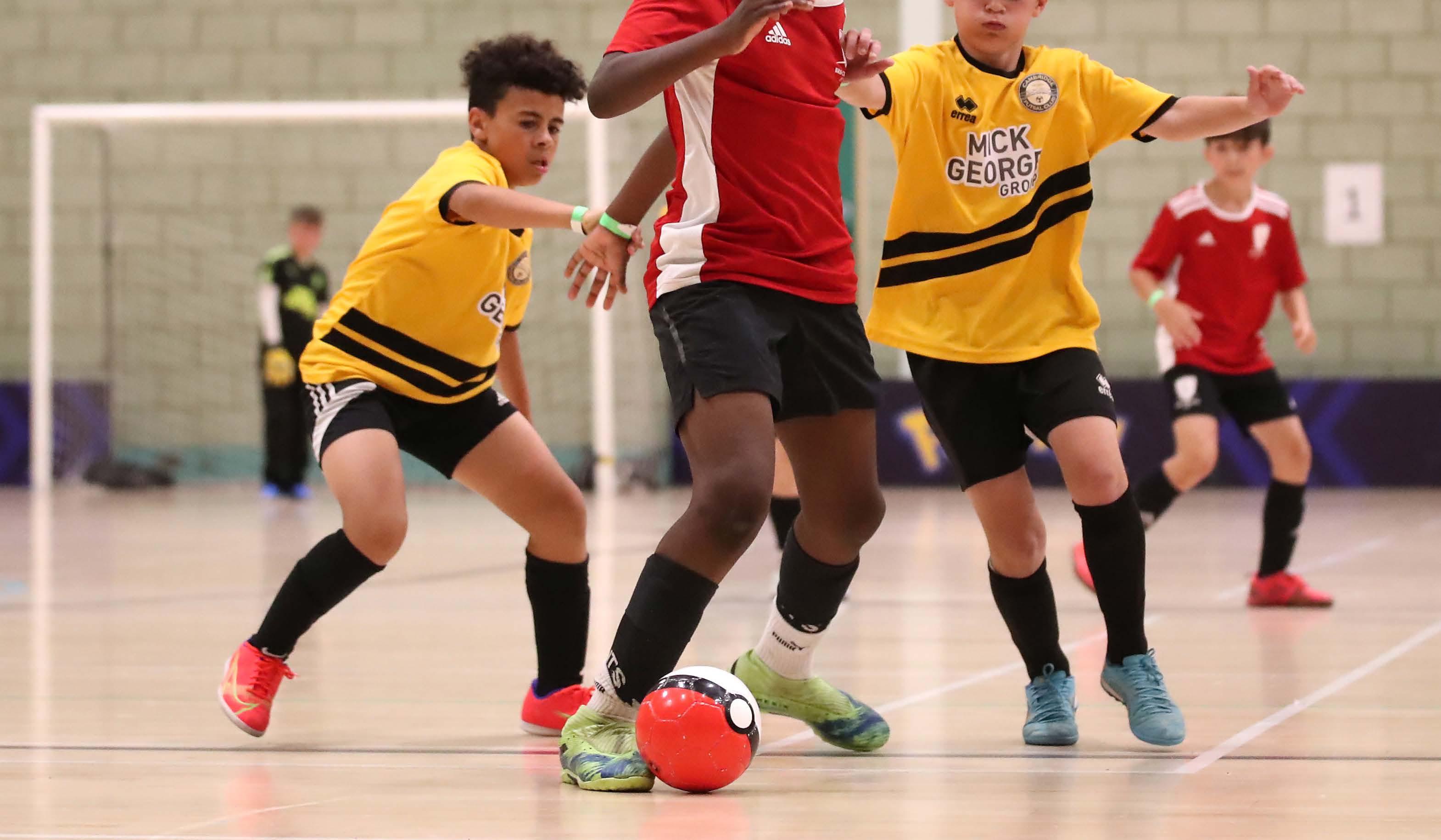
• When the ball goes out of play, the player in possession of the ball has four seconds to restart play with a kick-in, goal clearance, corner kick or free kick.
• Referees count with their fingers by their side to show how many seconds.
• Restart of play after 4 seconds infringement should be to the opposition not a free kick.
• Goalkeepers are not allowed to control the ball for more than four seconds in their own half.

• To restart the game after a ball has gone out of play, the ball is kicked back into play from the touch line and from corners .
• The ball must be stationary on the touch line.
• Only the kicker may be off the pitch to take the kick in.
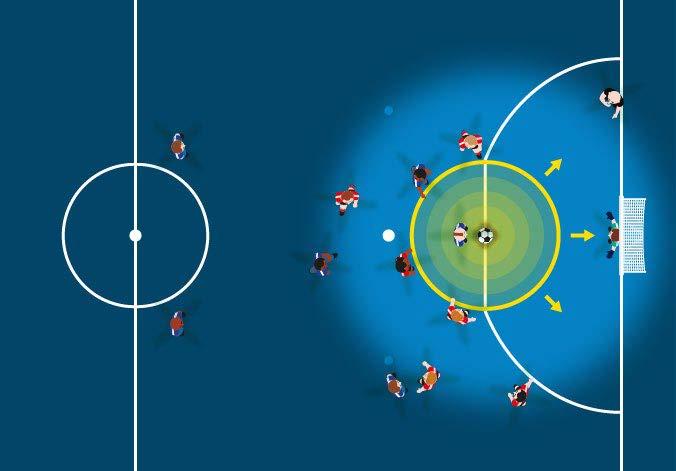
• The five metre law applies to all kick-ins, goal clearances, free kicks, and corners.
• Penalties distance is 6m or edge of the ‘D’.
• Players are required to be this distance away from the player in possession of the ball. Kick in
Penalties 6 metres or edge of the ‘D’

• Goalkeepers are allowed to come OUT of the penalty area. Outfield players are allowed IN the penalty area (PICTURED).
• A goal clearance must be thrown out by the goalkeeper. The goalkeeper cannot touch the ball again until he or she has crossed into the opponents half or a member of the opposition has touched the ball.
• Back passes to the goalkeeper are not allowed in Futsal. The four second rule applies to the GK in possession also.

• At international level 14 players would be used in one match. At lower levels it is recommended to be 10/12.
• There is no limit on how long a player must stay on or off the pitch.
• Players must enter and leave the field of play from the substitution zone.
• Roll on roll off substitutions can be made at any time during the game with permission from the referee, including players who have already been substituted.
• For young players in the Foundation Phase 50% game time is recommended.
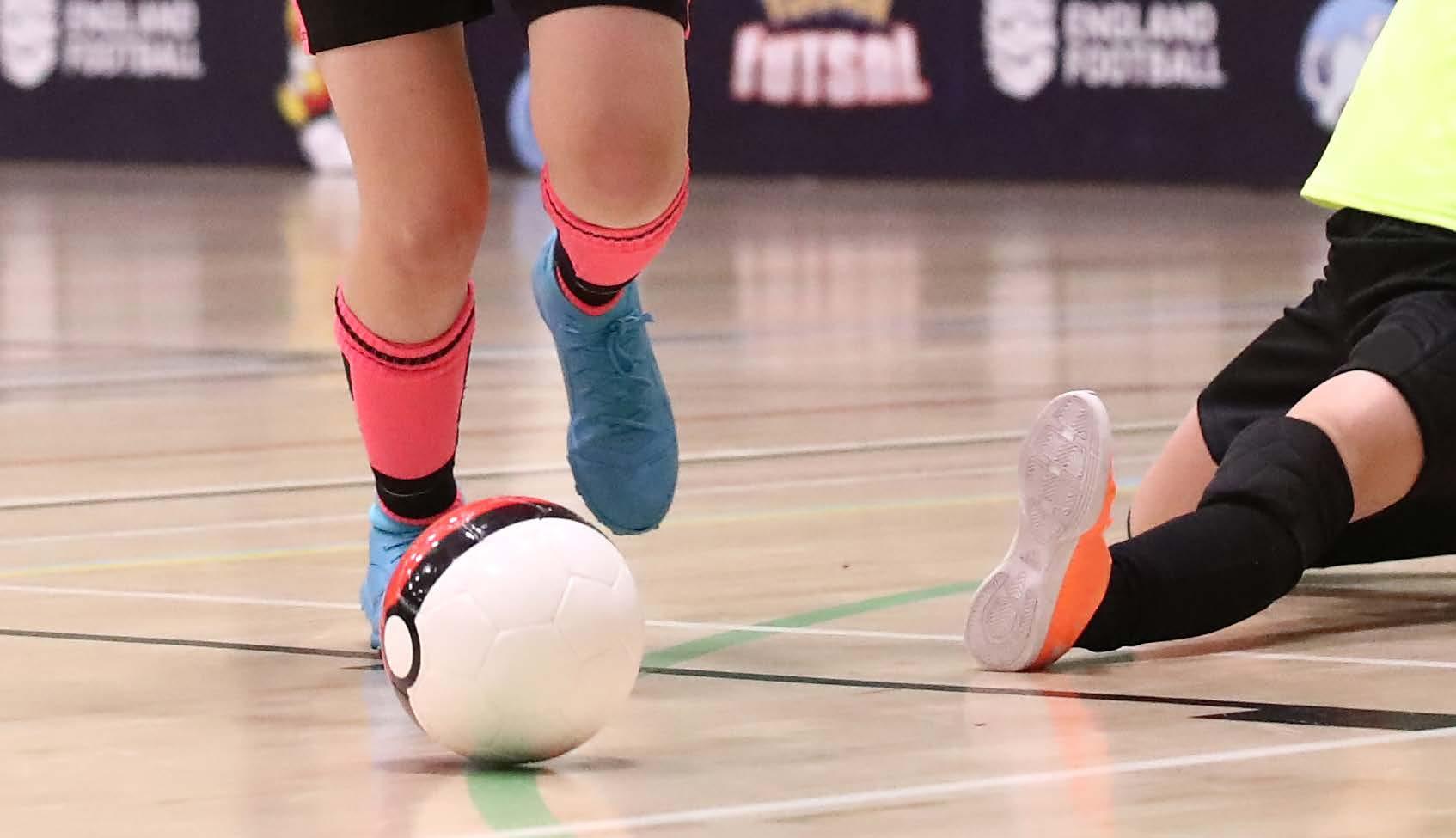
• Slide tackles are not permitted in Youth Futsal in ENGLAND (up to age U16).
• The only time players ARE permitted to slide is to keep the ball in play.
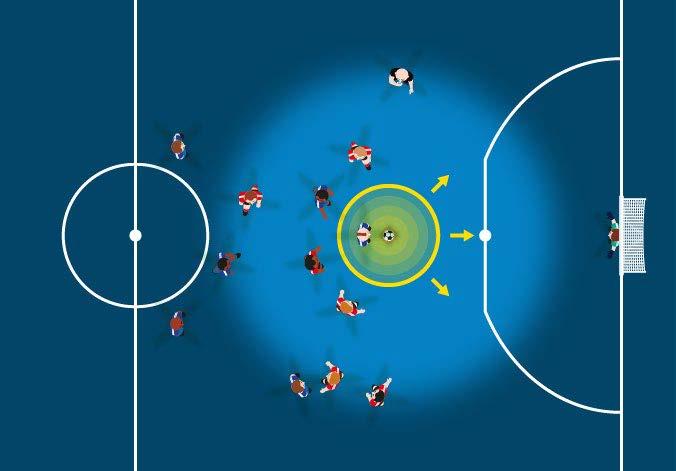
• Each team will be allowed to give away five direct free kicks in each half. On the sixth foul, a 10m penalty kick is awarded to the opposing team and every foul after that in the same half is also a 10m penalty (pictured).
• The defending team is not allowed to position any players (other than the goalkeeper) between the ball and the goal. The kick may be taken from the 10m mark or, if the foul was committed closer to the goal than 10m, from the position where the foul took place.

• If a player is sent off, their team must remain with four players until either two minutes have passed or the opposition has scored a goal.

Futsal facilities in England are improving all the time. But there are now many more people wanting to play and especially wanting to introduce young players to the game.
How many netball courts do we have in England? Futsal fits well on a netball court – inside or out!
With this in mind these are the five basics. Without them, it is not a game of Futsal:
The surface must be a hard court.
5 v 5
The ball must be a heavier Futsal ball – size 3 or size 4.
The format must be 5v5 on court – up to 14 in total per team.
The pitch must have touchlines not played off walls.
Must use 3m × 2m Futsal Goals – handball goal size.
Futsal has now been embedded into the England Coaching DNA. It is a fantastic game in its own right, but it brings so many other benefits to young players:
Develop skills
Improve decision making
Learn to innovate on the pitch
Develop different game strategies
Gain more flexible movement
Learn different tactics
Play with the emphasis on freedom and enjoyment